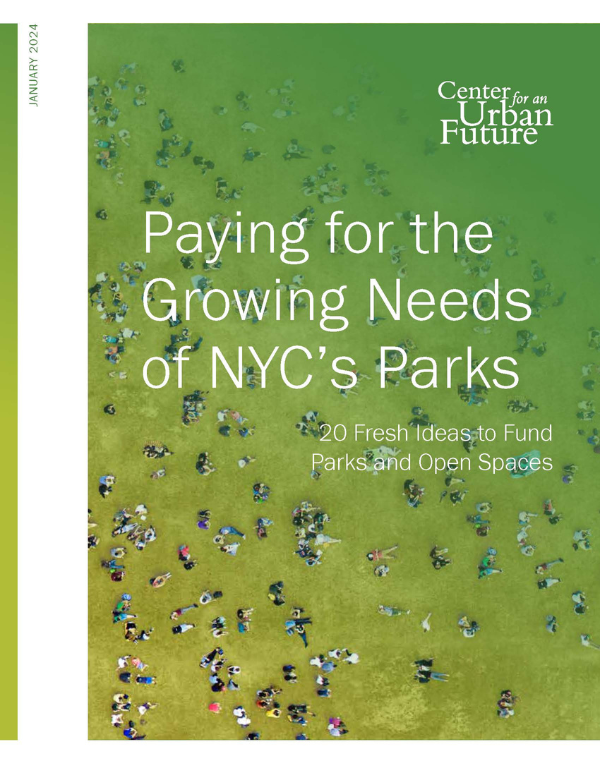Testimony of Eli Dvorkin
Editorial & Policy Director, Center for an Urban Future
Before the NYC Council Committee on Parks & Recreation
March 8, 2019
My name is Eli Dvorkin and I’m the editorial and policy director of the Center for an Urban Future (CUF). As many of you may know, CUF is a nonprofit, nonpartisan think tank and policy organization focused on expanding economic opportunity and strengthening communities across all five boroughs.
For more than 20 years, we’ve published in-depth research on an array of topics critical to the city’s future, including major reports on everything from supporting entrepreneurship in low-income communities and boosting community college graduation rates to revitalizing aging infrastructure and unlocking new opportunities to create middle-class jobs.
Nearly two years ago, our team of researchers set out to understand the role that parks play as vital urban infrastructure—and the threats that the system faces in the years ahead.
What we found is alarming.
Our report, A New Leaf, reveals for the first time that the average New York City park is 73 years old. Across all five boroughs, most parks are at least half a century old, ranging from an average age of 51 years on Staten Island to 86 years in Manhattan. A quarter of New York’s parks are at least 84 years old, and one park in 10 was built before 1898.
Moreover, we found that parks in every borough are struggling with aging assets that are at or near the end of their useful lives—including drainage systems, retaining walls, and bridges.
The age of our system comes at a cost. Over the past decade, state-of-good-repair needs—which includes major infrastructure and capital repairs—increased by 45 percent, from $405.9 million in fiscal year 2007 to $589.1 million in fiscal year 2017. Meanwhile, the department’s recommended maintenance needs increased by 143 percent, from $14 million to $34 million. And that figure is likely just a fraction of the real need.
Yet, just 15 percent of the recommended state-of-good-repair needs, and 12 percent of the maintenance needs, were funded in the most recent year. That’s at or near the lowest levels of any agency.
While the mounting infrastructure needs are largely due to the age of the system and record usage of parks in recent years, our research finds that the problems have been compounded by decades of under-investment in basic parks maintenance and inadequate spending on infrastructure upgrades. The result is that NYC has fewer skilled parks maintenance workers than other big-city systems—and that smaller issues end up growing into bigger problems.
In total, our report found just 39 plumbers for the entire parks system. Similarly, the city has about 150 gardeners citywide for nearly 20,000 acres of parkland—a ratio of one gardener to every 133 acres. By comparison, the San Francisco Recreation and Parks Department has over 200 gardeners for 4,113 acres of parkland, a ratio of one gardener to 20 acres.
The consequences are clear on the ground. Some districts—like Bronx’s Community Board 8—had zero dedicated gardeners, while others have just one, which makes effective horticultural maintenance impossible.
These problems extend far beyond horticulture. For the parks system’s miles of power lines and countless fixtures, there were just 27 electricians and one supervising electrician as of FY 2018. By comparison, Chicago, with less than a quarter the parks acreage of New York, had 32 electricians on staff. Likewise, our research found just nine cement masons and two helpers for all parks citywide.
This shortage is symptomatic of a larger trend: the city’s parks system has suffered disproportionately in the aftermath of previous recessions—and the next downturn is on the horizon.
Since the 1970s fiscal crisis, the full-time staffing headcount of the Parks Department has dropped from a high of 11,642 in 1976 to a little over 7,600—a 35 percent decline. This means not only fewer skilled workers to fix pipes, point masonry, clear catchbasins, and tend to horticulture, but also a lack of capacity to gather data, speed up capital projects, and maintain consistent relationships with community members.
Despite these concerns, our report finds that recent investments in chronically underfunded parks are having a meaningful impact, and we commend Mayor de Blasio, the City Council, and Commissioner Silver for launching the Community Parks and Anchor Parks Initiatives, and we urge their continuation. These initiatives are improving parks equity while tackling underlying infrastructure needs, but those needs remain urgent.
Our report concludes with more than 20 specific and achievable recommendations for revitalizing the city’s aging parks infrastructure. But here are three critical next steps:
- Support the Play Fair for Parks campaign. To ensure that capital dollars are spent wisely, the Parks Department needs new resources to help maintain its infrastructure. We recommend increasing the department’s maintenance and operations budget by $100 million, which can allow the department to baseline desperately needed skilled staff positions, increase the number and range of assets that receive regular maintenance, improve data-gathering, and focus on mitigating problems before they grow.
- Increase long-term funding for parks capital projects. For far too many parks infrastructure projects, the need to cobble together capital funding from the mayor and individual councilmembers means that vital but overlooked projects like replacing drainage systems and reinforcing retaining walls end up delayed or unfunded. The department urgently needs more capital dollars that can be allocated at the discretion of the commissioner and his team. We recommend at least $100 million annually in new discretionary capital funding and a 10-year capital plan that accurately reflects the needs of the system’s aging infrastructure.
- Identify new opportunities to increase revenues. Parks Department revenues from sources like concessions have been largely flat over the past few years. Our report includes several suggestions for ways to boost revenues while maintaining a quality experience for parkgoers, such as a small surcharge on sporting and concert event tickets and greens fees at golf courses; a modest increase in dockage fees at publicly owned marinas; new opportunities to develop concessions in areas with few such options; and more systematic inclusion of parks funding as part of rezoning agreements.
- Reform the capital construction process. With so many needs, capital dollars need to stretch further than they do today. Under Commissioner Silver, the department has implemented some important reforms to the design and construction phases. But major issues remain in both the planning and procurement phases, where projects end up mired in an approvals process that includes the Parks Department, elected officials, community groups, and oversight agencies such as OMB and the Comptroller. The city is in the process of launching the first major overhaul of the capital construction system, but these efforts will only be successful if every agency with a hand in the process commits to the shared goal of improving project delivery. We encourage the mayor and the City Council to hold every agency accountable to this urgent goal.
Photo Credit: Jon Tyson/Unsplashed




